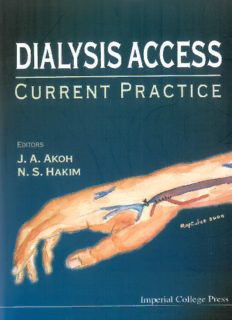Table Of ContentDIALYSIS ACCESS
CURRENT PRACTICE
DIALYSIS ACCESS
CURRENT PRACTICE
EDITORS
J. A. AKOH
DERRIFORD HOSPITAL, PLYMOUTH, UK
N. S. HAKIM
IMPERIAL COLLEGE SCHOOL OF MEDICINE AT
ST. MARY'S HOSPITAL, UK
4wfr- Imperial College Press
Published by
Imperial College Press
57 Shelton Street
Covent Garden
London WC2H 9HE
Distributed by
World Scientific Publishing Co. Pte. Ltd.
P O Box 128, Farrer Road, Singapore 912805
USA office: Suite IB, 1060 Main Street, River Edge, NJ 07661
UK office: 57 Shelton Street, Covent Garden, London WC2H 9HE
British Library Cataloguing-in-Publication Data
A catalogue record for this book is available from the British Library.
DIALYSIS ACCESS
Current Practice
Copyright © 2001 by Imperial College Press
All rights reserved. This book, or parts thereof, may not be reproduced in any form or by any means,
electronic or mechanical, including photocopying, recording or any information storage and retrieval
system now known or to be invented, without written permission from the Publisher.
For photocopying of material in this volume, please pay a copying fee through the Copyright
Clearance Center, Inc., 222 Rosewood Drive, Danvers, MA 01923, USA. In this case permission to
photocopy is not required from the publisher.
ISBN 1-86094-169-9
Printed in Singapore.
FOREWORD
As we enter the 21st century, it is striking to remember that clinical dialysis
has been possible for only the last four decades. As with transplantation,
there has been tremendous evolution. Patients with end-stage renal disease
(ESRD) now have a number of alternatives for therapy — haemodialysis,
peritoneal dialysis and transplantation. And care of the patient with ESRD
requires an integrated program where patients can transfer from one modality
to another.
Central to the care of the ESRD patient is a comprehensive dialysis
program. For an individual patient, dialysis may be the primary therapy, may
be done in preparation for transplantation, or may be initiated after failure of
a kidney transplant. Critical to a successful dialysis program is a thorough
understanding and appreciation of vascular access.
It is likely that most patients with ESRD, including those waiting for a
cadaver kidney transplant, will spend years receiving dialysis. Thus, long-
term planning is essential. Unfortunately, all too often, dialysis access surgery
is not given appropriate attention. It must be appreciated that as a means for
long-term dialysis, such surgery is life-saving. Importantly, there are a limited
number of surgical options for any one patient. And unless the access surgery
is done properly, the options may be rapidly used up.
This volume provides the global perspective necessary for planning,
initiation, and long-term care of dialysis access. Detailed are the algorithms
for the initial choice of access and how to care for access-related morbidity.
Important consideration is given to reoperative surgery and to access surgery
for patients with technically challenging issues. The indispensable roles of
both diagnostic and interventional radiology and of nursing care of dialysis
access sites are delineated.
Written by individuals experienced in the field, this volume provides
insight into this difficult area. The required team approach — nephrology,
vi Foreword
surgery, nursing and radiology — is readily apparent. This volume, edited
by two experts in the field, summarises current practices and provides a
stepping stone for the future.
Arthur Matas MD
University of Minnesota Hospital
Minneapolis USA
LIST OF CONTRIBUTORS
Jacob A Akoh FMCS, FWACS, FRCSEd, FRCSEd(Gen), FICS
Consultant General Surgeon
Plymouth Hospitals NHS Trust
Level 03, Derriford Hospital
Derriford Road
Plymouth PL6 8DH, UK
Murat A Akyol MD, FRCS
Consultant Surgeon
Scottish Liver Transplant Unit
Royal Infirmary of Edinburgh
1 Lauriston Place
Edinburgh EH3 9YW, UK
Aghiad Al-Kutoubi MD, FRCR, DMRD
Professor and Chairman
Department of Diagnostic Radiology
American University of Beirut Medical Centre
Beirut, Lebanon
Kenneth L Brayman MD, PhD
Associate Professor of Surgery
Director of Renal Transplantation
University of Pennsylvania Medical School
Children's Hospital
Philadelphia, PA 19104
USA
Vll
viii List of Contributors
Paul W Chamney BEng(Hons), PhD, AMIEE
Department of Electrical and Electronic Engineering
University of Hertfordshire
Hatfield
Herts ALIO 9AB, UK
Adil Eltayar DIC, MSc, FRCS
Clinical Fellow
Transplant Unit
St Mary's Hospital
London W2 1NY, UK
Joanne Emery RGN
Nursing Sister
Haemodialysis Unit
Lister Hospital
Stevenage SGI 4AB, UK
Ken Farrington MD, FRCP
Consultant Nephrologist
Department of Renal Medicine
Lister Hospital
Stevenage
Herts SGI 4AB, UK
Oswald N Fernando FRCS, FRCSEd
Consultant Transplant Surgeon
Transplantation Unit
Royal Free Hospital
Pond Street
London NW3 2QG, UK
Albert G Hakaim MD, MSc, FACS
Associate Professor of Surgery
Section of Vascular Surgery
Mayo Clinic
4500 San Pablo Road
Jacksonville, FL 32224
USA
Nadey S Hakim MD, PhD, FRCS, FACS, FICS
Consultant Surgeon
Surgical Director Transplant Unit
St Mary's Hospital
London W2 1NY, UK
Philip Korsah MB, ChB, DA, FFARCSI
Research Fellow
Clinical Shock Study Group
Western Infirmary, Dumbarton Road
Glasgow Gil 6NT, UK
Paul A Lear FRCS
Consultant Vascular and Transplant Surgeon
Renal Transplant Unit
Southmead Hopspital
Westbury-on-Trym
Bristol BS10 5NB, UK
Derek Manas BSc, MBBCh, FCS(SA)
Consultant Surgeon
Liver Unit
Level 5 Ward 12
The Freeman Hospital
Newcastle Upon Tyne NE7 7DN, UK
Description:The incidence of treated end stage renal disease (ESRD) continues to rise, particularly in the western world. Although renal transplantation is the treatment of choice for ESRD, the decline in the number of cadaveric organs, coupled with the rising demand for transplantation, means that an increasin

